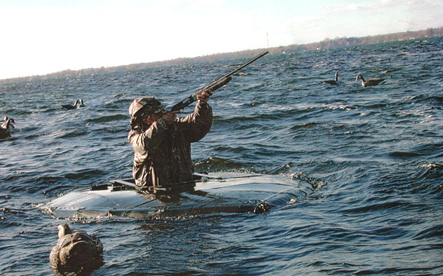BERETTA Model A 300 Semiautomatic Shotgun |
||||||||||||||||||||||||||||||||||||||||||||||||||||||||||||||||||||||||||||
The automatics, or self loading shotguns, according to their principle of operation fall into two main groups, namely: - recoil operated and, When a recoil operated gun is discharged both the bolt and the barrel, locked together, recoil back for approximately three inches. At the rearmost position, the bolt is caught and held back while the barrel returns to its original position. Thus, two separate springs are needed... one to return the barrel to its forward position, and one to return the bolt, since both are separate operations. When the barrel and bolt are moved to the rear at the time of discharge, two springs are compressed: then, white the bolt is held in the open (rearward) position, the barrel return spring pushes the barrel forward until it releases the bolt locking latch, allowing the bolt to come forward, feeding a new shot shell. The design of such a system is necessarily a rather complicated one, and in most recoil operated shotguns the gun must be adjusted to handle the particular load being used. In addition, the large weight and mass of the barrel and bolt moving under recoil results in the so called «double shuffle» effect, a combination of the clatter and noise of these parts, and the separate inertia of their movements. The basic principle of the gas operated mechanism, on the other hand, is the utilization of part of the gas pressure in the barrel to move a piston which in turn operates the action bar and the bolt. |
||||||||||||||||||||||||||||||||||||||||||||||||||||||||||||||||||||||||||||
|
||||||||||||||||||||||||||||||||||||||||||||||||||||||||||||||||||||||||||||
The
Beretta Model A 300 uses this system. The Beretta Model A 300 features a built in load adjuster, making ft possible to shoot interchangeably all 2 ¾ " shotshells, from the lightest target loads to the heaviest magnums, without adjustment. The front of the piston is built in such a way as to be able to expand against the walls of the expansion chamber in direct relationship to the pressure of the gas on it. The heavier the load, the more the « Lips » of the piston, press outward to apply extra braking power to retard the piston's rearward motion; the less pressure, the less braking action, so that the rearward movement is accomplished at the same rate of speed regardless of the power of the shotshell used. Thus, before the bolt is unlocked and carried to the rear, the shot charge is well clear of the muzzle, and pressures, within the barrel have dropped to a safe level. As the bolt travels back, it extracts and ejects the fired case, and a fresh round is released from the magazine. As the bolt and action bar travel forward, the bolt brings forward the new shell, chambers it, and locks itself closed, ready for firing. After the last round has been fired, the bolt remains open. Because of the ring shaped grooves milled into the outer contour of the piston, the piston actually scrubs the walls of the expansion chamber, resulting in a self cleaning action that eliminates the need for frequent cleaning. |
||||||||||||||||||||||||||||||||||||||||||||||||||||||||||||||||||||||||||||
A301 |
||||||||||||||||||||||||||||||||||||||||||||||||||||||||||||||||||||||||||||
The
advantages of the Beretta A 300 are manifold: - clean lines, exceptional natural pointing qualities, - high muzzle velocity resulting in quicker and more accurate shooting, - greatly reduced recoil, - minimal wear on the moving parts due to the smooth operation of the mechanism, - reduced number of components, - simple takedown, - trouble free performance. The A 300 automatic is typical of Beretta's care and quality. Utilizing
the latest equipment, Beretta has achieved the ultimate in automatic
shotguns. The reliability of the Mode] A 300 automatic under
every known condition is also due in large measure to the use
of the finest materials, machined and heat treated to rigid
standards. |
||||||||||||||||||||||||||||||||||||||||||||||||||||||||||||||||||||||||||||
|
||||||||||||||||||||||||||||||||||||||||||||||||||||||||||||||||||||||||||||
In
production from the 1966~ to the 1970~ |
||||||||||||||||||||||||||||||||||||||||||||||||||||||||||||||||||||||||||||
Beretta Web - Beretta model A300, the first and the best!
Beretta 92 History
| Beretta 92 DeLuxe
| Beretta Billenium
| Beretta 90-TWO
| Beretta 92
| Beretta 92S
| Beretta 92SB
Beretta 93R
| Beretta Target
| Beretta 92 Combat
| Beretta 92 .22LR Kit
| Beretta 92A1
| Beretta Vertec Steel
| Beretta 92 Gost
Beretta 418
| Beretta 1931-1934
| Beretta 1934
| Beretta 70 series
| Beretta 90
| Beretta 950
| Beretta 9000
Beretta 80 Series
| Beretta 86
| Beretta 89
| Beretta U22
| Beretta 8000
| Beretta 51
| Beretta Olympic




 Roger
D. & A390 in Action
Roger
D. & A390 in Action